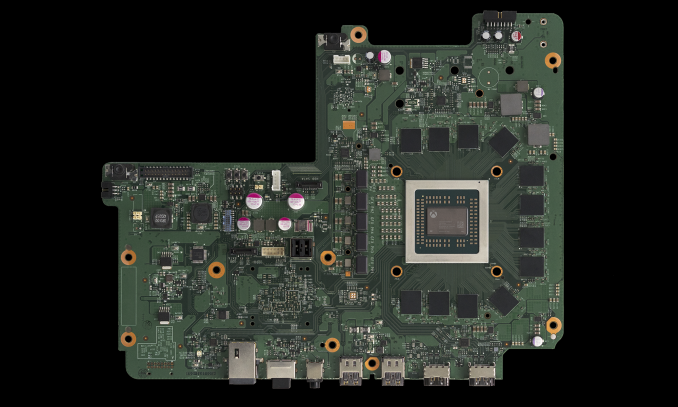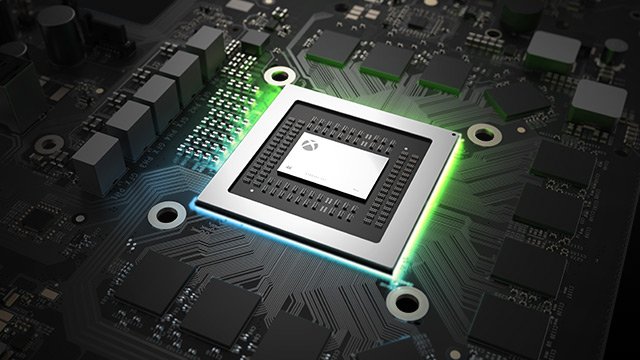The Xbox One X Review: Putting A Spotlight On Gaming
by Brett Howse on November 3, 2017 3:01 AM EST- Posted in
- Consoles
- Microsoft
- Xbox One
- Xbox
- Xbox One X
Powering Xbox One X: The Scorpio Engine
The heart of the Xbox One X is a custom AMD APU, which Microsoft is dubbing the Scorpio Engine. This APU features eight CPU cores and forty GPU compute units, essentially making it a vastly more powerful version of the APU found in the original Xbox One. All of this is built on TSMC’s 16 nm fab process, packing seven billion transistors into 360 mm2. Amazingly, that’s almost exactly the same size die as the original Xbox One, although quite a bit larger than the 240 mm2 of the Xbox One S, which is also built on TSMC 16 nm. Thanks to quite a bit of disclosure from Microsoft between the time the Xbox Project Scorpio was announced, until the launch of the Xbox One X, we know quite a bit about what’s powering the latest console.
 Image Source: Digital Foundry
Image Source: Digital Foundry
Eight Custom CPU Cores
The original Xbox One featured eight CPU cores based on the AMD Jaguar microarchitecture, and the Xbox One X keeps that completely intact. There’s still eight cores, and they are still based on a slightly upgraded version of Jaguar. Microsoft stated the CPU performance increased 31% over the original console, and they achieved that with a frequency bump from 1.75 GHz to 2.3 GHz.
This likely came down to several factors. They may have been able to leverage Ryzen cores, but it would have been difficult to get Ryzen into the new APU on the timelines required. Jaguar is also going to take up less of their die space as well, which is important when you are limited by your total die budget, and as we saw with the Xbox One’s eSRAM, taking die space for non-GPU functions can be a problem. Finally, since the Xbox One X will be completely backwards compatible with the Xbox One, keeping the same CPU architecture likely makes this an easier transition.
Microsoft calls these custom CPU cores, and while we’ll likely never get all of the information on what’s custom on them, Microsoft has released a couple of details. In particular, these new CPU cores implement a page descriptor cache of nested translations, which is a fairly low level optimization to the cache design that allows Microsoft to offset some of the remaining overhead that comes from their use of virtual machines by better caching the VM's memory operations. This optimization gets the Scorpio Engine a few percent more in average CPU performance. But regardless, the custom x86 CPU is 31% faster than the original Xbox One thanks to a 31% higher frequency. Clearly the team’s testing and research showed that this was enough CPU for the expected requirements.
12 GB GDDR5 System Memory
Arguably the biggest change to the Xbox One X is the move from 8 GB of DDR3 with a 32 MB eSRAM buffer, to 12 GB of GDDR5 memory, clocked at 6.8 Gbps. This isn’t just because there’s more RAM, but more because it gets rid of the eSRAM. The Xbox One X has twelve 32-bit channels for the GDDR5, resulting in a 384-bit memory interface. Coupled with the 6.8 Gbps data rate, that provides 326 GB/s of system memory bandwidth. 9 GB of RAM is available to developers, with 3 GB reserved for the system to handle multi-tasking. The original plan for a 4K dashboard got dropped to provide more RAM to developers, so the 3 GB matches the same reservation as the original Xbox One console.
The original Xbox One had just 68.3 GB/s of system memory bandwidth, and compensated with a 102 GB/s bi-directional eSRAM buffer. The Xbox One X no longer requires that buffer, thanks to copious amounts of bandwidth for main memory, which frees up a lot of die space on the APU. I wonder what they’ll use that space for?
40 GPU Compute Units at 1172 MHz
Microsoft was able to invest almost all of the free die space from the removal of the eSRAM into improving the GPU. The Xbox One X ships with the most powerful GPU in any console, and features an AMD custom GPU.
The heart of the Xbox One X is a GPU that's roughly based on AMD’s GCN 4 (Polaris) architecture. It offers 40 compute units, 2560 stream processors, and 32 ROPs. For comparison, an AMD Radeon RX 480 offers 36 CUs, so the Xbox One X offers 11% more compute hardware than the RX 480. Compared to the PlayStation 4 Pro, the Xbox One X offers about 43% more shader throughput.
There’s of course more custom blocks here as well. A console designed for 4K and HDR still needs to work with SDR 1080p displays, and the Xbox display controller can supersample down from 4K to 1080p, or even 1440p, as needed. There’s media blocks for HEVC as well, to handle the 4K video requirements for Blu-Ray and streaming, and the Xbox Game Capture can also capture at 4K now.
Storage: SATA HDD
For those hoping for all flash based storage in their console, those days are still a long way off. The amount of storage needed for games, especially those with 4K assets, is copious, to say the least, so for now we’re stuck with spinning disks. Digital Foundry reports that the Xbox One X will have 50% more bandwidth to the hard drive, which likely means the latest model is finally SATA III, rather than SATA II, for the 2.5” HDD. Unlike the short lived Xbox One Elite, there doesn’t appear to be any SSHD options at this time.
If you need extra storage, the Xbox One supports external USB storage. It would be nice if Microsoft had made it possible to replace the internal storage easily, but so far, they don’t seem to want to do that. Adding external storage is pretty simple though.
UHD Blu-Ray
Like the Xbox One S, the Xbox One X ships with a UHD Blu-Ray drive, allowing you to play UHD/4K movies with HDR support. There’s no support for Dolby Vision currently.
Hardware Summary
There’s a lot of performance packed into the new Xbox One X. Microsoft was too conservative with the original Xbox One, and they seem to be out to prove that they won’t make that mistake again. This is a console designed to target 4K right from the start. As to how successful they will be, that will depend on the developers, and the ever-evolving trade-off between more complex scenes, and higher resolution, but with a GPU that is almost five times more powerful than the original Xbox One, coupled with 12 GB of 384-bit GDDR5, and a faster CPU, the aim looks like its on target.













128 Comments
View All Comments
Jumangi - Saturday, November 4, 2017 - link
Cause they had no reason too?12GB of 384bit GDDR5 means plenty of bandwidth.
vladx - Saturday, November 4, 2017 - link
I think he meant original Xbox One/S using eDRAM instead of eSRAM.vladx - Saturday, November 4, 2017 - link
eSRAM is faster and more power efficient than eDRAM already, that's the reason.NXTwoThou - Friday, November 3, 2017 - link
I'm just shocked it didn't launch with Mixed Reality support.mooninite - Friday, November 3, 2017 - link
I can't wait for the Xbox One XXX!!... oh, wait.trane - Friday, November 3, 2017 - link
Polaris has developed a poor reputation for being inefficient, but this just shows how efficient it can really be. Scorpio Engine's GPU is basically RX 580 level of shader throughput, but with greatly increased memory bandwidth. (Yes, I'm aware it's shared, but given the memory bandwidth of a mainstream CPU, it's still ahead)Scorpio Engine uses something like ~120W over idle, at load. RX 580 is more like 180W over idle.
That is an insane 50% increase in perf/W. PS4 Pro is even more efficient, but perhaps that's not fair because it's just clocked so low.
Even compared to the similarly clocked RX 470s, the Scorpio Engine draws similar amount of power for at least 25% more performance. You want another comparison? That's also how much power a reference GTX 1060 draws, and I'm willing to bet Scorpio Engine is a tad faster.
Could it be TSMC simply has a large advantage over GF? After all, Nvidia's 14nm GP107 clocks much lower than their other higher end 16nm chips, too. I mean,
Dragonstongue - Friday, November 3, 2017 - link
likely a result of MSFT taking the time to optimize the core voltage for the clocks needed, something AMD did not seem to do, a 570 or a 580, heck most of the various Radeon released the last couple of years can use a fair amount LESS power/heat while upping the clocks when the base voltage or power slider is adjusted, almost like AMD did not truly optimize the settings or somethingSuppose MSFT took that extra time to fully tune the cpu and gpu side of the equation to get them as close to minimal power draw as possible which helps them keep costs of BOM down (cooling required, power supply needs etc)
would be really nice if Xbox offered something PS4 does not, seeing as they are windows esque, more office productivity type stuff such as word pads, media player etc, like a mini computer they seem to want to try and emulate, that is the one thing stopping ME from buying any current console, cannot do what I can on my PC, that s take notes, wordpads to track my daily costs and so forth.
vladx - Saturday, November 4, 2017 - link
Like Dragonstongue says above, it's mostly because Microsoft requested heavily-binned GPU dies which allowed them to optimize perf/w to the utmost limit. Nothing to do with the fab used, a heavily-binned GTX 1060 would most likely be even more power efficient than that.UltraWide - Friday, November 3, 2017 - link
Does it have HDMI-CEC support?scbundy - Friday, November 3, 2017 - link
I imagine so. When I turn off the Xbox One, it turns off the Receiver and the TV.